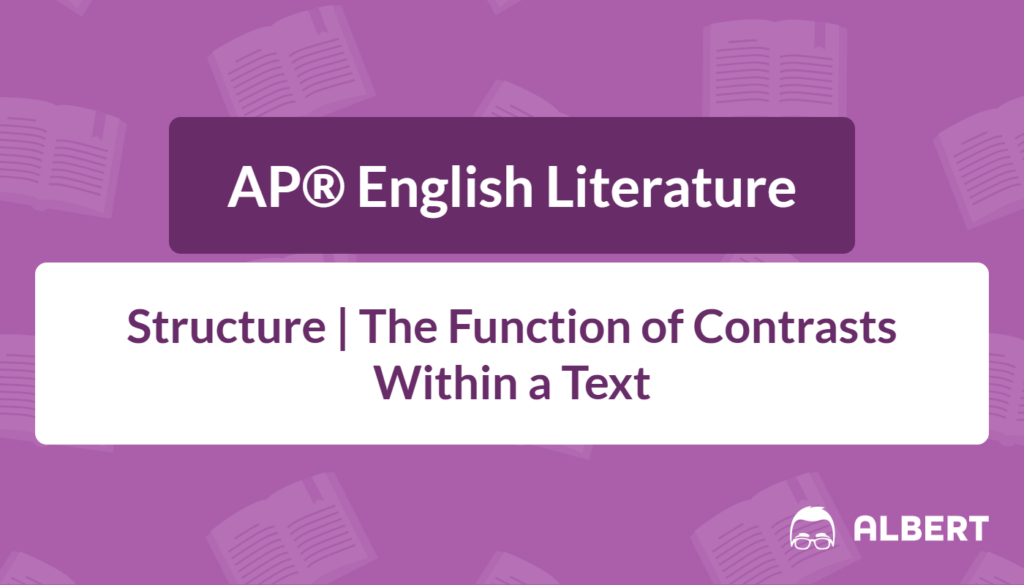Contrasts often create some of the most memorable moments in literature. Readers become more aware of a story’s deeper meaning when authors place opposing ideas or characters side by side. This blog explores why contrasts matter, how to spot them, and ways to discuss them effectively on the AP® English Literature exam. In this post, you’ll learn how to confidently compare and contrast text structure, with clear explanations to help you understand each step.
What We Review
Defining Contrast in Literature
A definition of contrast in literature involves placing distinct or opposing elements in close proximity. This technique draws attention to differences that might otherwise go unnoticed. For instance, a sweet, innocent character confronting a harsh, gloomy setting highlights the stark contrast of hope versus despair.
Authors use contrasts to make themes clearer or to deepen character relationships. They might also rely on symbolic contrasts—such as light versus dark imagery—to emphasize a conflict. Structural analysis of a text often reveals how these opposing elements underscore a work’s central message or tension.
The Role of Juxtaposition in Literature
Contrast frequently appears through juxtaposition, which sets two or more ideas, images, or characters side by side for immediate comparison. This is one of the most direct juxtaposition examples found in literary works, as it draws readers’ attention precisely where the author wants it.
In William Shakespeare’s play Romeo and Juliet, the feud between the Montague and Capulet families frames the love of the title characters. Although they come from opposing backgrounds, their relationship blossoms amid family hatred. This tension appears in Juliet’s remark:“ ‘My only love sprung from my only hate…’” Here, love and hate sit side by side in the same sentence, intensifying the emotional impact. When reading such lines, it helps to pause and note the opposing words. Then, consider how they define the characters’ situation and add tragedy to their love story.
Analyzing Contrast Through Different Aspects
Theme Comparison
Contrasts in themes often reveal a work’s central concerns. Opposing themes—like freedom vs. confinement, hope vs. despair, or love vs. hate—make abstract ideas more tangible.
In Romeo and Juliet, the themes of love and hate run parallel. First, notice the immediate clash: Romeo and Juliet’s romance exists within an environment of intense family rivalry. Second, track how these two themes progress together throughout the play. Finally, link this contrast to Shakespeare’s message: even potent hatred can be shaken by love. By showing these extremes side by side, the text underscores how love and hate share a fragile boundary.
Character Contrast
Writers often position characters with contrasting traits to highlight strengths and weaknesses. This is evident in F. Scott Fitzgerald’s novel The Great Gatsby. Jay Gatsby is a dreamer, longing for an idealized vision of love, while Tom Buchanan stands for entitlement and brute force.
When analyzing Gatsby vs. Tom Buchanan, start by identifying their main personality traits:
- Gatsby is mysterious, idealistic, and self-made.
- Tom is wealthy, aggressive, and often careless.
Then, explore how Fitzgerald places these characters in similar scenes, like at parties or in conversations with Daisy. Observe how their different attitudes toward money and love collide. For instance, Gatsby’s fascination with the green light shows romantic longing, while Tom’s dismissive behavior reveals arrogance. Finally, connect how the tension between their worldviews highlights the novel’s commentary on the American Dream.
Setting Contrast
Sometimes, an author uses place to highlight themes or characters’ emotions. In poetry, settings can shift abruptly to reveal contrasting moods or outlooks.
Take Robert Frost’s poem “The Road Not Taken” as an example. The narrator encounters two different paths in a wood. One path seems less traveled, while the other appears more worn. Although both paths share similarities, this subtle contrast captures the human desire to choose a unique direction in life.
When reading this poem, identify descriptive lines—such as how one path is “grassy and wanted wear”—that emphasize difference. Notice the time Frost spends comparing the paths. By setting these roads side by side, Frost encourages readers to reflect on decisions and possible outcomes.

Using Compare and Contrast Text Structure
These examples highlight the power of the compare and contrast text structure. Authors deliberately arrange content to draw attention to crucial differences. This structure pushes readers to see how separate elements interact, leading to insights about the entire work.
When writing essays or responding to prompts, this structure can be a valuable tool. It helps organize thoughts around clear comparisons, then moves toward meaningful conclusions. Therefore, students who can handle comparison and contrast effectively often uncover deeper interpretations of theme, character, or symbol.
Practical Application: Analyzing a Literary Passage
A brief passage can illustrate how to identify and analyze contrasts in a more direct way. Consider this excerpt from Mary Shelley’s Frankenstein:
“ ‘I was benevolent and good; misery made me a fiend…’”
Step-by-step analysis:
- Identify the contrasting ideas: The speaker highlights a shift from kindness (“benevolent and good”) to malevolence (“fiend”).
- Note the cause: Misery triggers the character’s transformation. This immediate contrast between good and evil points to how suffering can distort one’s nature.
- Connect it to the novel’s themes: Shelley integrates questions about humanity, responsibility, and the thin line between compassion and cruelty.
Realize that small quotes often contain major contrasts. Focusing on key words like “benevolent” versus “fiend” leads to a richer understanding of character development.
Importance of Structural Analysis
Recognizing contrasts is just one part of structural analysis. When readers analyze structure, they consider the arrangement of scenes, the organization of ideas, and the use of literary devices. This helps reveal deeper layers of meaning. By looking for moments of opposition—such as two clashing characters, themes, or moods—students can trace how these elements reinforce the text’s broader messages.
Moreover, an awareness of structure enhances essay writing. It allows students to build organized arguments. Readers can systematically explain how a text’s arrangement clarifies or complicates its meaning. In AP® Literature, this can prove invaluable for constructing well-developed free-response essays that address a writer’s purposeful choices.
Quick Reference Chart: Key Vocabulary
| Term | Definition or Key Feature |
| Contrast | The placement of opposing elements to highlight differences. |
| Juxtaposition | The side-by-side arrangement of ideas for emphasis. |
| Compare and Contrast Structure | A method of organizing writing to explore similarities and differences. |
| Theme Comparison | Contrasting major ideas like love/hate or freedom/confinement to reveal deeper meaning. |
| Character Foil | A character whose traits sharply contrast with another, illuminating key qualities. |
| Setting Contrast | Use of opposing places or environments to highlight mood and tone differences. |
| Structural Analysis | Evaluation of how parts of a text (scenes, chapters, stanzas) are arranged to create meaning. |
| Symbolic Contrast | When light/dark or other imagery is used to underscore conflicting ideas or themes. |
Conclusion
Contrasts give literature its vibrancy. Whether through theme, character, or setting, seeing differences clearly encourages readers to interpret stories more deeply. Identifying these moments involves spotting opposing words or images and thinking about their purpose. By studying how authors employ compare and contrast text structure, students can shape more refined arguments and discussions. Embracing literary contrasts not only aids in crafting strong essays for the AP® Literature exam but also opens a gateway to enjoying the layers and complexity that make reading truly rewarding.
Sharpen Your Skills for AP® English Literature and Composition
Are you preparing for the AP® English Literature and Composition test? We’ve got you covered! Try our review articles designed to help you confidently tackle real-world AP® English Literature and Composition problems. You’ll find everything you need to succeed, from quick tips to detailed strategies. Start exploring now!
- AP® English Literature: Plot Structure
- AP® English Literature: Sequence of Events
- AP® English Literature: Analyzing Structure
- AP® English Literature: How Plot Events Shape Meaning
- AP® English Literature: Conflict in a Story
Need help preparing for your AP® English Literature and Composition exam?
Albert has hundreds of AP® English Literature and Composition practice questions, free response, and full-length practice tests to try out.








